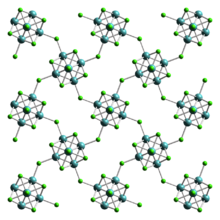Chemistry:Tungsten(II) iodide

| |
| Identifiers | |
|---|---|
3D model (JSmol)
|
|
| ChemSpider | |
PubChem CID
|
|
| |
| |
| Properties | |
| I2W | |
| Molar mass | 437.65 g·mol−1 |
| Appearance | dark brown solid[1] |
| Density | 6.79 g·cm−3[2] |
| Melting point | 800 °C (decomposes)[2] |
| insoluble[2] | |
| Related compounds | |
Other anions
|
tungsten(II) chloride tungsten(II) bromide |
Other cations
|
chromium(II) iodide molybdenum(II) iodide |
Related compounds
|
tungsten(III) iodide |
Except where otherwise noted, data are given for materials in their standard state (at 25 °C [77 °F], 100 kPa). | |
| Infobox references | |
Tungsten(II) iodide is an iodide of tungsten, with the chemical formula [W6I8]I4, or abbreviated as WI2.
Preparation
Tungsten diiodide can obtained from the decomposition from tungsten(III) iodide:[1]
- 6 WI
3 → [W
6I
8]I
4 + 3 I
2
It can also be formed by the displacement reaction of tungsten(II) chloride and iodine:[1]
- [W
6Cl
8]Cl
4 + 12 I → [W
6I
8]I
4 + 12 Cl
It can also be formed by the direct reaction of tungsten and iodine, which is a reversible reaction. This reaction can be used in halogen lamps.[3]
- W + I
2 ⇌ WI
2
Tungsten(II) iodide can also be obtained by reacting tungsten hexacarbonyl with iodine.[4]
Properties
Tungsten(II) iodide is a dark brown-colored solid that is stable in air and moisture. Its structure is the same as tungsten(II) chloride, crystallising orthorhombic crystal system, with space group Bbem (No. 64), and lattice parameters a = 1258 pm, b = 1259 pm, c = 1584 pm.[1]
References
- ↑ 1.0 1.1 1.2 1.3 Handbuch der präparativen anorganischen Chemie. 3 (3., umgearb. Aufl ed.). Stuttgart: Enke. 1981. ISBN 978-3-432-87823-2.
- ↑ 2.0 2.1 2.2 Haynes, William M.; Lide, David R.; Bruno, Thomas J. (2012). CRC handbook of chemistry and physics: a ready reference book of chemical and physical data (93rd ed.). Boca Raton: CRC. ISBN 978-1-4398-8049-4.
- ↑ Latscha, Hans Peter; Mutz, Martin (2011). Chemie der Elemente. Chemie-Basiswissen. Berlin Heidelberg: Springer. ISBN 978-3-642-16915-1.
- ↑ Johnson, Brian Frederick Gilbert (1972). Inorganic chemistry of the transition elements. A specialist periodical report. London: Chemical society. ISBN 978-0-85186-500-3.
| HI | He | ||||||||||||||||
| LiI | BeI2 | BI3 | CI4 | NI3 | I2O4, I2O5, I4O9 |
IF, IF3, IF5, IF7 |
Ne | ||||||||||
| NaI | MgI2 | AlI3 | SiI4 | PI3, P2I4 |
S | ICl, ICl3 |
Ar | ||||||||||
| KI | CaI2 | Sc | TiI4 | VI3 | CrI3 | MnI2 | FeI2 | CoI2 | NiI2 | CuI | ZnI2 | Ga2I6 | GeI2, GeI4 |
AsI3 | Se | IBr | Kr |
| RbI | SrI2 | YI3 | ZrI4 | NbI5 | Mo | Tc | Ru | Rh | Pd | AgI | CdI2 | InI3 | SnI4, SnI2 |
SbI3 | TeI4 | I | Xe |
| CsI | BaI2 | HfI4 | TaI5 | W | Re | Os | Ir | Pt | AuI | Hg2I2, HgI2 |
TlI | PbI2 | BiI3 | Po | AtI | Rn | |
| Fr | RaI2 | Rf | Db | Sg | Bh | Hs | Mt | Ds | Rg | Cn | Nh | Fl | Mc | Lv | Ts | Og | |
| ↓ | |||||||||||||||||
| La | Ce | Pr | Nd | Pm | SmI2 | Eu | Gd | TbI3 | Dy | Ho | Er | Tm | Yb | Lu | |||
| Ac | ThI4 | Pa | UI3, UI4 |
Np | Pu | Am | Cm | Bk | Cf | EsI3 | Fm | Md | No | Lr | |||
 |

